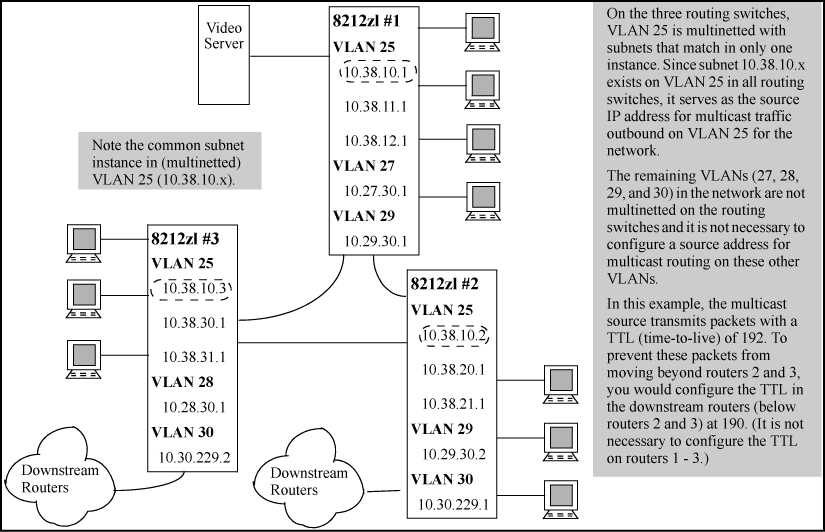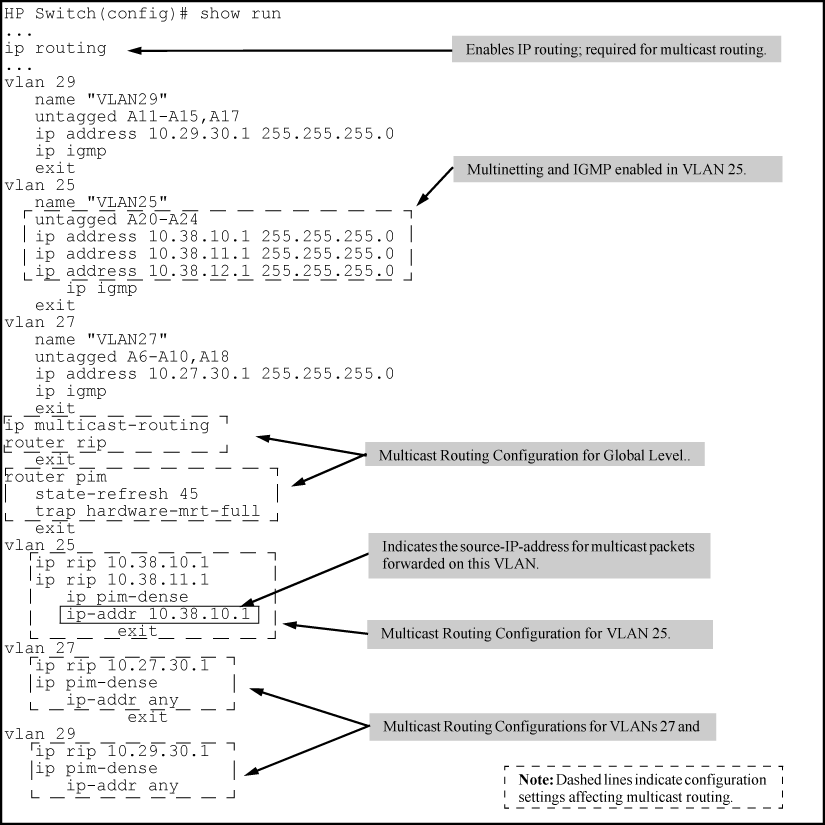Syntax:
In networks using multinetted VLANs, all routers on a given VLAN intended to route multicast packets must have a least one common subnet on that VLAN. Use this command when the VLAN is configured with multiple IP addresses (multinetting) to specify the IP address to use as the source address for PIM protocol packets outbound on the VLAN.
Syntax:
Changes the frequency at which the routing switch transmit PIM hello messages on the current VLAN. The routing switch uses hello packets to inform neighboring routers of its presence. The routing switch also uses this setting to compute the hello hold time, which is included in hello packets sent to neighbor routers. hello hold time tells neighbor routers how long to wait for the next hello packet from the routing switch. If another packet does not arrive within that time, the router removes the neighbor adjacency on that VLAN from the routing table, which removes any flows running on that interface.
Shortening the hello interval reduces the hello hold time. This has the effect of changing how quickly other routers will stop sending traffic to the routing switch if they do not receive a new hello packet when expected.
NOTE: Not used with the
[no]form of theip pim-densecommand.
Example:
If multiple routers are connected to the same VLAN and the routing switch requests multicast traffic, all routers on the VLAN receive that traffic. (Those that have pruned the traffic will drop it when they receive it.)
If the upstream router loses contact with the routing switch receiving the multicast traffic (that is, fails to receive a hello packet when expected), the shorter hello interval causes it to stop transmitting multicast traffic onto the VLAN sooner, resulting in less unnecessary bandwidth usage.
Syntax:
Changes the maximum time in seconds before the routing switch actually transmits the initial PIM hello message on the current VLAN. In cases where a new VLAN activates with connections to multiple routers, if all of the connected routers sent hello packets at the same time, the receiving router could become momentarily overloaded. This value randomizes the transmission delay to a time between 0 and the hello delay setting. Using 0 means no delay.
After the routing switch sends the initial hello packet to a newly detected VLAN interface, it sends subsequent hello packets according to the current hello interval setting.
NOTE: Not used with the
[no]form of theip pim-densecommand.
Syntax:
Graft packets result when a downstream router transmits a request to join a flow. The upstream router responds with a graft acknowledgment packet. If the graft ack (acknowledgement) is not received within the time period of the graft-retry-interval, it resends the graft packet. The command
[graft-retry-interval[1-10]]changes the interval (in seconds) the routing switch waits for the graft ack from another router before resending the graft request.
NOTE: Not used with the
[no]form of theip pim-densecommand.
Syntax:
Changes to the number of times the routing switch will retry sending the same graft packet to join a flow. If a graft ack response is not received after the specified number of retries, the routing switch ceases trying to join the flow. In this case the flow is removed until either a state-refresh from upstream re-initiates the flow or an upstream router floods the flow.
Increasing this value helps to improve multicast reliability.
NOTE: Not used with the
[no]form of theip pim-densecommand.
Syntax:
Enables the LAN prune delay option on the current VLAN. With lan-prune-delay enabled, the routing switch informs downstream neighbors how long it will wait before pruning a flow after receiving a prune request. Other, downstream routers on the same VLAN must send a Join request to override the prune before the lan-prune-delay times out if they want the flow to continue. This prompts any downstream neighbors with hosts continuing to belong to the flow to reply with a Join. If no joins are received after the LAN prune-delay period, the routing switch prunes the flow.
The propagation-delay and override-interval settings determine the lan-prune-delay setting.
NOTE: Uses the
[no]form of theip pim-densecommand to disable the LAN prune delay option.
Syntax:
ip pim-dense[propagation-delay[250-2000]]
vlan[[propagation-delay[250-2000]]vid]ip pim-dense
ip pim-dense[override-interval[500-6000]]
vlan [[override-interval[500-6000]]vid]ip pim-denseA routing switch sharing a VLAN with other multicast routers uses these two values to compute the lan-prune-delay setting for how long to wait for a PIM-DM Join after receiving a prune packet from downstream for a particular multicast group.
Defaults: propagation-delay=500 milliseconds; override-interval = 2500 milliseconds
Upstream router prune
A network may have multiple routing switches sharing VLAN "X". When an upstream routing switch initially floods traffic from multicast group "X" to VLAN "Y", if one of the routing switches on VLAN "Y" does not want this traffic, it issues a prune response to the upstream neighbor. The upstream neighbor then goes into a prune pending state for group "X" on VLAN "Y". (During this period, the upstream neighbor continues to forward the traffic.)
During the prune pending period, another routing switch on VLAN "Y" can send a group "X" Join to the upstream neighbor. If this happens, the upstream neighbor drops the prune pending state and continues forwarding the traffic. If no routers on the VLAN send a Join, the upstream router prunes group "X" from VLAN "Y" when the lan-prune-delay timer expires.
Syntax:
Sets the multicast datagram time-to-live (router hop-count) threshold for the VLAN. Any IP multicast datagrams or state-refresh packets with a TTL less than this threshold will not be forwarded out the interface. The default value of 0 means all multicast packets are forwarded out the interface.
The VLAN connected to the multicast source does not receive state refresh packets and thus is not state-refresh capable. Downstream VLANs in the switches covered in this guide are state-refresh capable. This parameter provides a method for containing multicast traffic within a network, or even within specific areas of a network. Initially, the multicast traffic source sets a TTL value in the packets it transmits. Each time one of these packets passes through a multicast routing device, the TTL setting decrements by 1. If the packet arrives with a TTL lower than the
mroute ttl-threshold, the routing switch does not forward the packet.Changing this parameter on a routing switch requires knowledge of the TTL setting of incoming multicast packets:
Default: 0—forwards multicast traffic regardless of packet TTL setting
The network in Multicast network with a multinetted VLAN uses VLAN 25 for multicast traffic. However, this VLAN is multinetted and there is only one subnet (10.38.10.x) in VLAN 25 that is common to all three routing switches. Thus, when configuring VLAN 25 on these routing switches to perform multicast routing, it is necessary to use ip pim-dense to designate the common subnet as the source address for outbound multicast traffic on VLAN 25. (If only identical subnets were present in the multinetted VLAN 25 configuration on all three devices, the source-ip-addressip pim-dense ip-addr any command would be used instead.) The other VLANs in the network are not multinetted and therefore do not require the ip pim-dense ip-addr any|source-ip-address option.
For this example, assume that the VLANs and IP addressing are already configured on the routing switch.
Multicast network with a multinetted VLAN illustrates the steps for configuring multicast routing at the VLAN level for the 8212zl switch #1 shown in Multicast network with a multinetted VLAN.
HP Switch(config)# vlan 25 HP Switch(vlan-25)# ip igmp HP Switch(vlan-25)# ip rip HP Switch(vlan-25)# ip pim-dense ip-addr 10.38.10.1 HP Switch(vlan-25-pim-dense)# vlan 27 HP Switch(vlan-27)# ip igmp HP Switch(vlan-27)# ip rip HP Switch(vlan-27)# ip pim-dense HP Switch(vlan-27-pim-dense)# vlan 29 HP Switch(vlan-29)# ip igmp HP Switch(vlan-29)# ip rip HP Switch(vlan-29)# ip pim-dense HP Switch(vlan-29-pim-dense)# write mem HP Switch(vlan-29-pim-dense)# exit HP Switch(vlan-29)# exit
![[NOTE: ]](images/note.gif)

